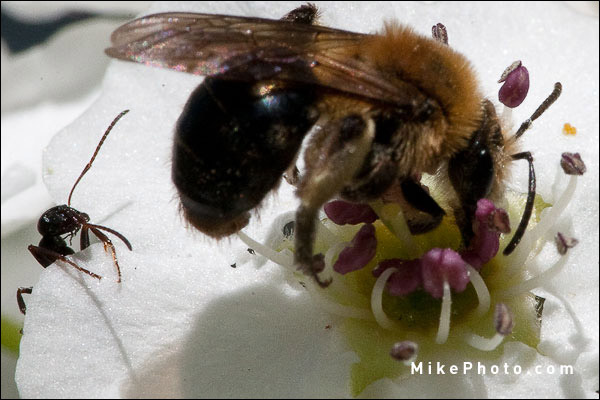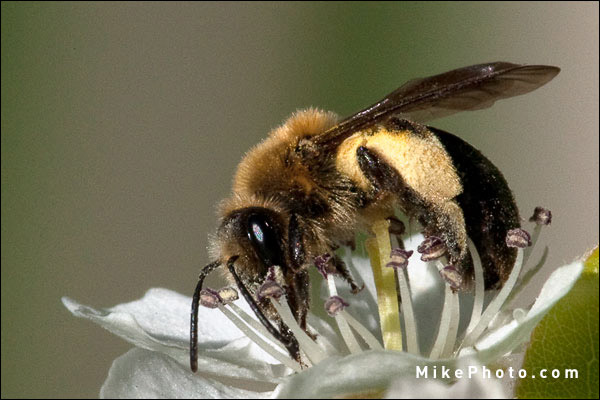Ant approaching the Ornamental Pear flower to feed on nectar.
In the 70s, scientists believed that flowers repel ants and that ants do not feed on flower nectar as it contains chemicals that are unattractive and indigestible. In the following years, new studies have shown quite the opposite. Several flower species have specialized to attract ants. The tropical orchid Spathoglottis plicata Blume for example, attracts ants using nectaries strategically placed on the base of flowers and its buds [Arthropods of Tropical Forests, 2003 ].
].
But you don't need to travel to tropics to witness ants feeding on flower nectar. You just need to look closely at the blooming Ornamental Pear tree. During spring, the Pyrus calleryana 'Chanticleer' blooms into tiny, pure white flowers, which not only will brighten your eyes but will also attract a variety of insects – honey bees, bumble bees, flies and ants.

Close-up of an Ant encounter with a Honey Bee on an Ornamental Pear flower.
The above photograph is just another example of the ant attraction to Ornamental Pear flowers. In this case, the ant arrived too late. Lunch was already served to the honey bee.
The Ornamental Pear tree makes flowers for pollination. The flowers are bright white with pink anthers and a yellow/green stamen base. Insect pollination occurs when insects transfer pollen from the male part of the plant to the female part of another plant that belongs to the same species. In the above case, the bee is the flower's preferred customer as flying insects have far better chances at pollinating other plants than ants.

Close-up of Honey Bee covered by dust-sized pollen, on Ornamental Pear tree flower.
Ornamental, spring-blooming trees are the perfect choice to bring your garden to life. For a photographer, they provide excellent opportunities to study up-close the large variety of insects that are attracted to their sweet nectar. If you are planning on expanding your garden, give the Ornamental Pear tree some serious consideration.
About the Ornamental Pear Tree
Gardening insights by Teo Lascut
Part of the Rose Family (Rosaceae) the Ornamental Pear is a reliable tree. Best transplanted at the end of winter or in early spring, with small but abundant white blooms in mid spring, before the leaves come out. Although the blooms are not particularly fragrant, it attracts many insects eager to explore after a long winter.
Typical to Ornamental Pear Trees are the upright pyramidal tree shape, and oval, shiny leaves. The ‘Chanticleer’ cultivar has a more columnar shape, working well in a small to medium garden, as well as large. It is very well suited for planting in narrow spaces. The leaves are more elongated and turn a bright orange-red in the fall. During that time of the year, the leaves are almost the last ones to drop amongst other tree species.
Ornamental Pear Trees are a favourite for landscapers due to resistance to illness and urban pollution, with great performance along the years.